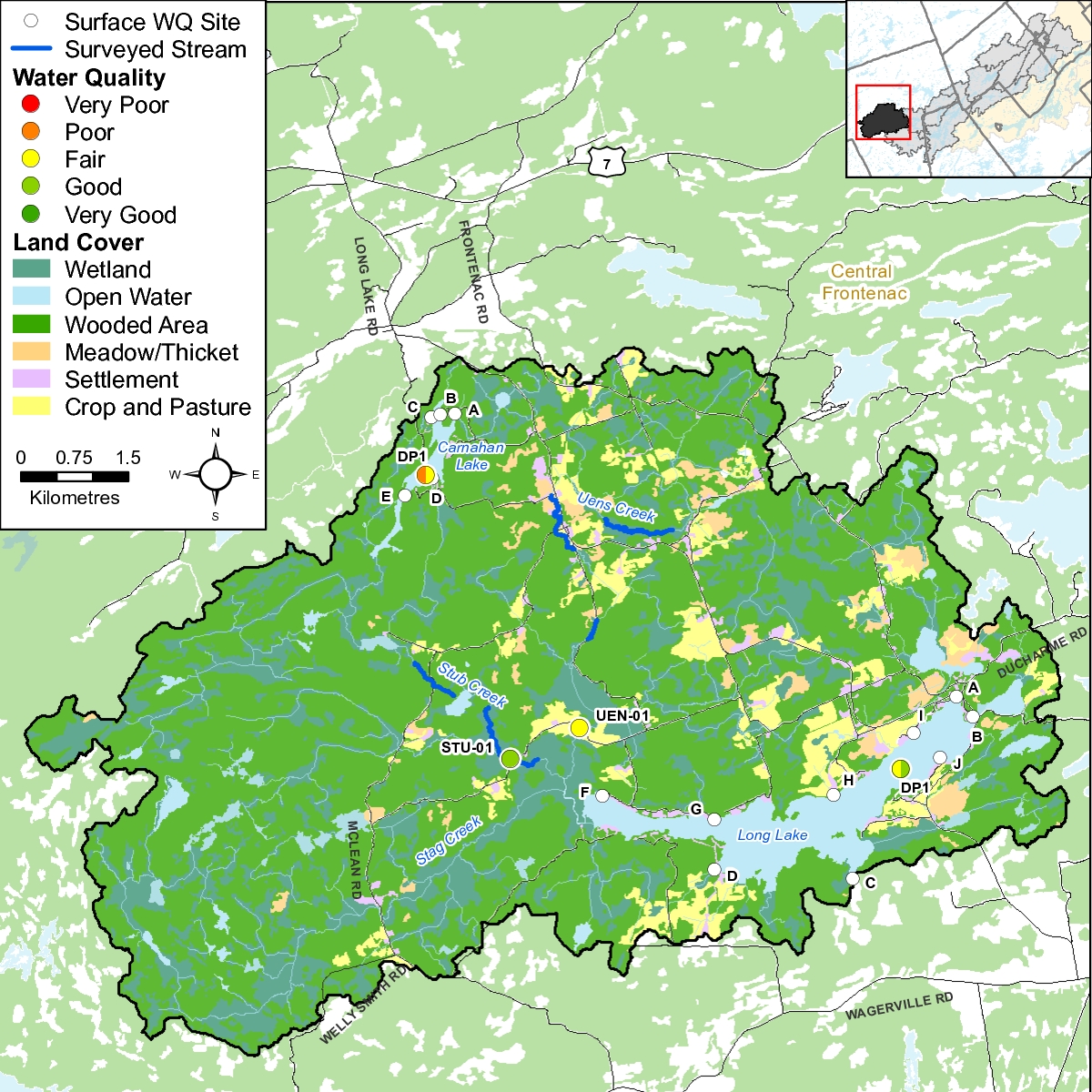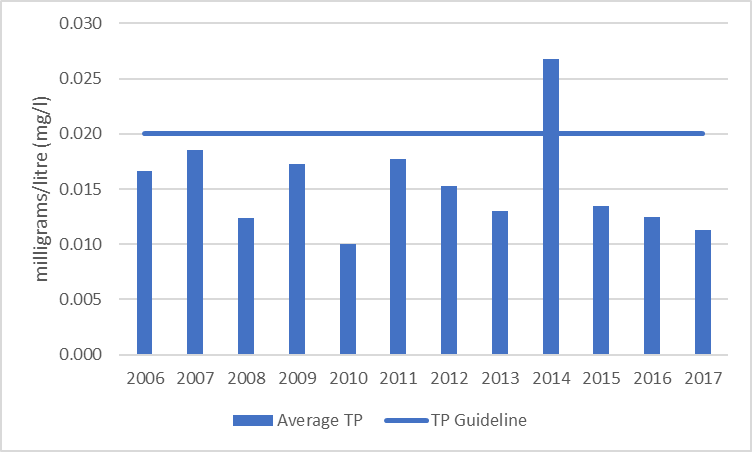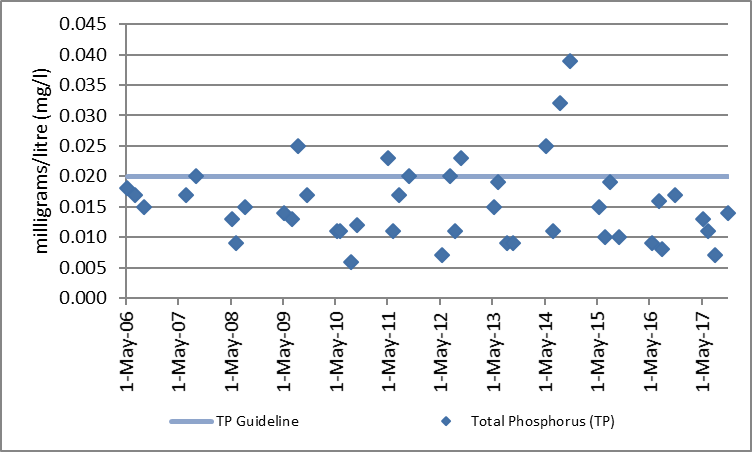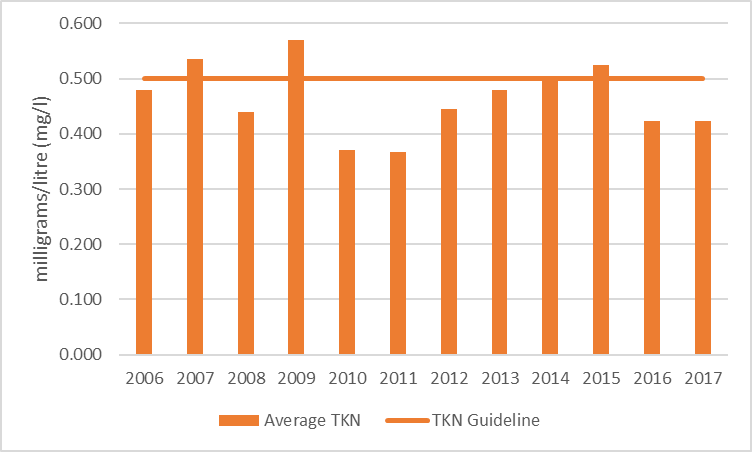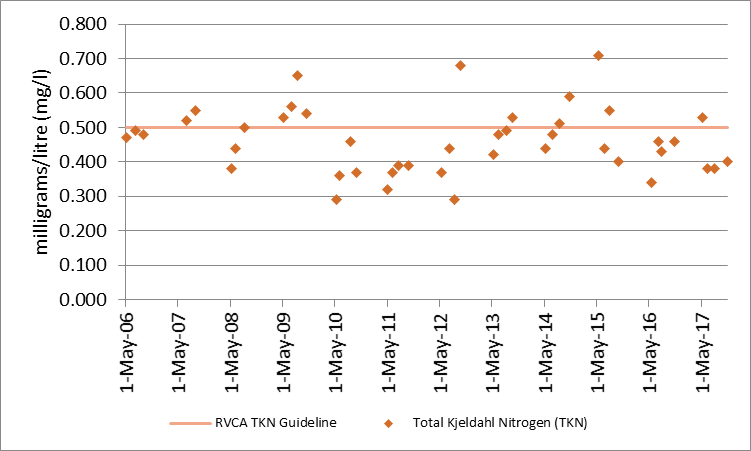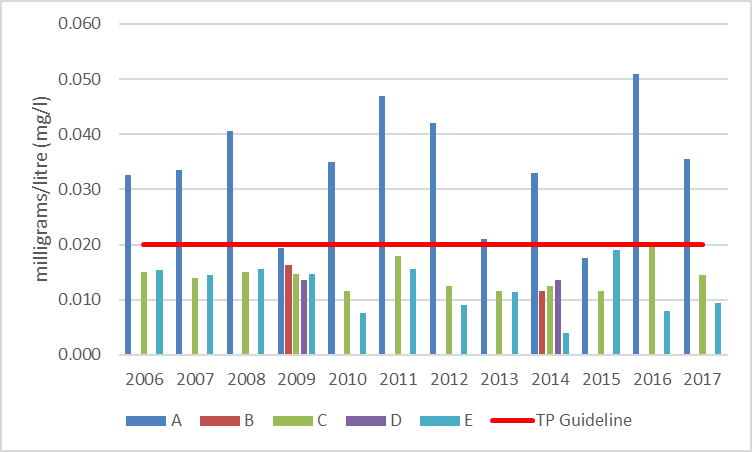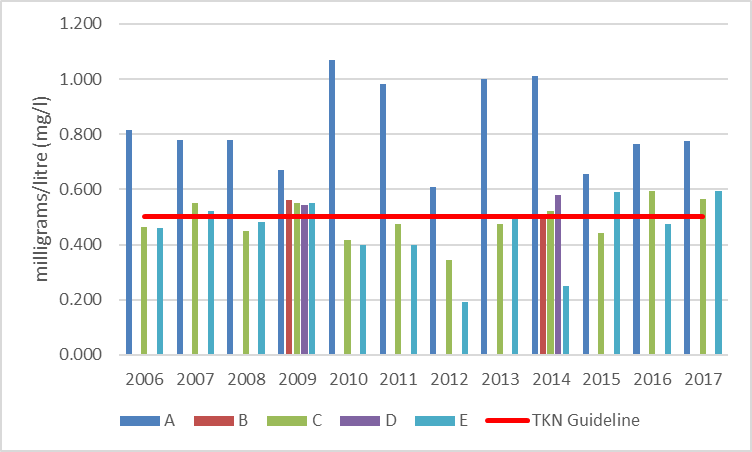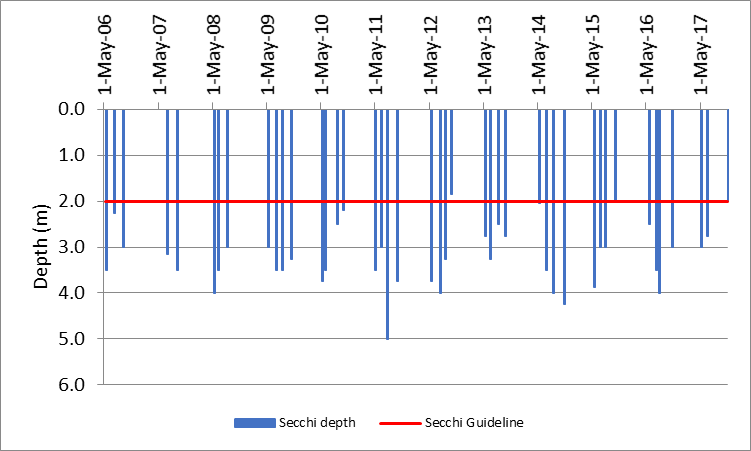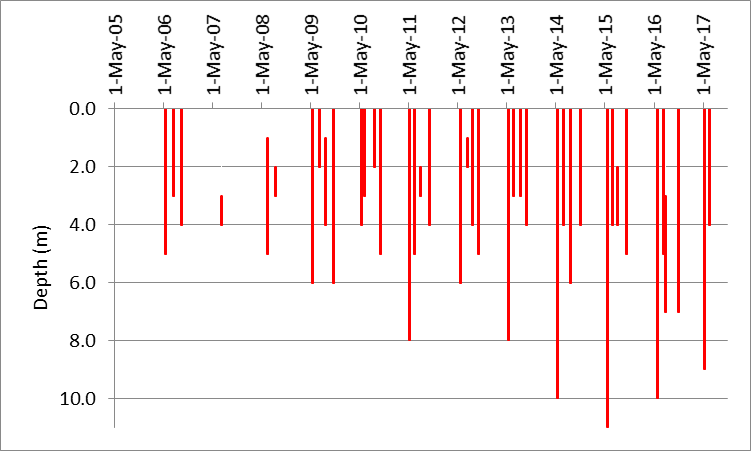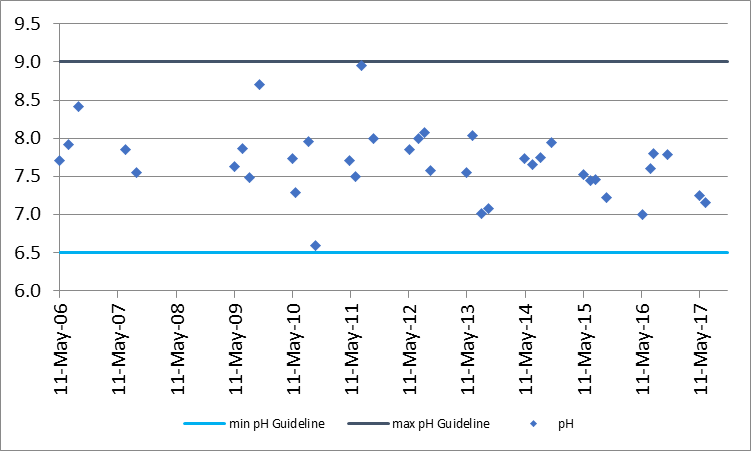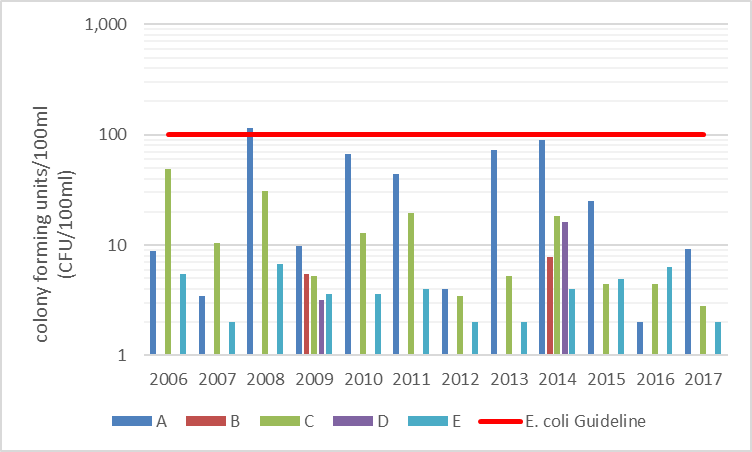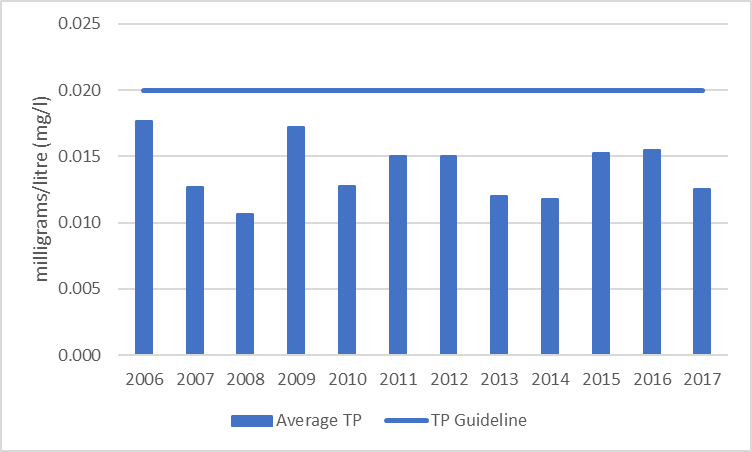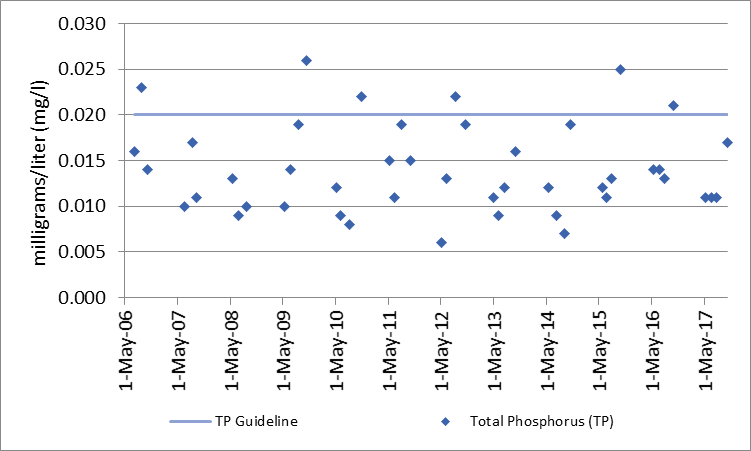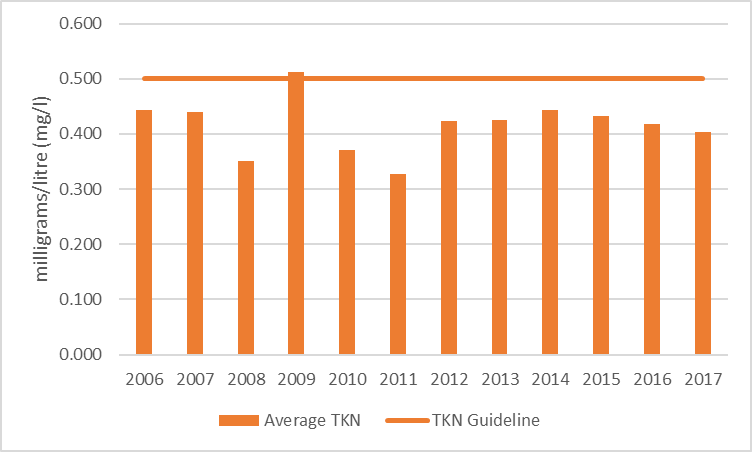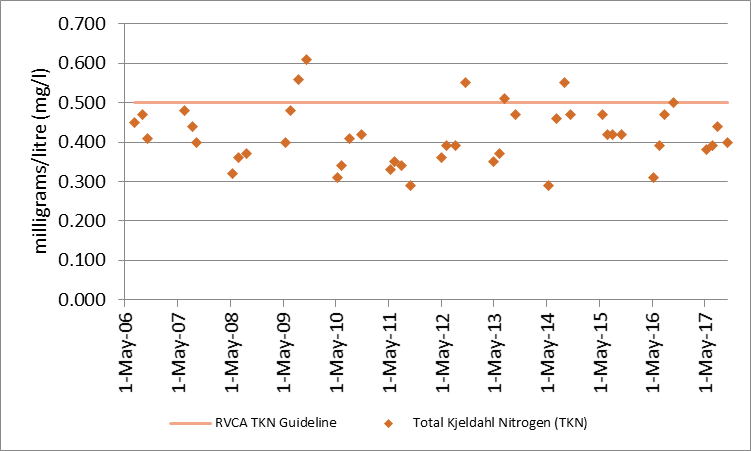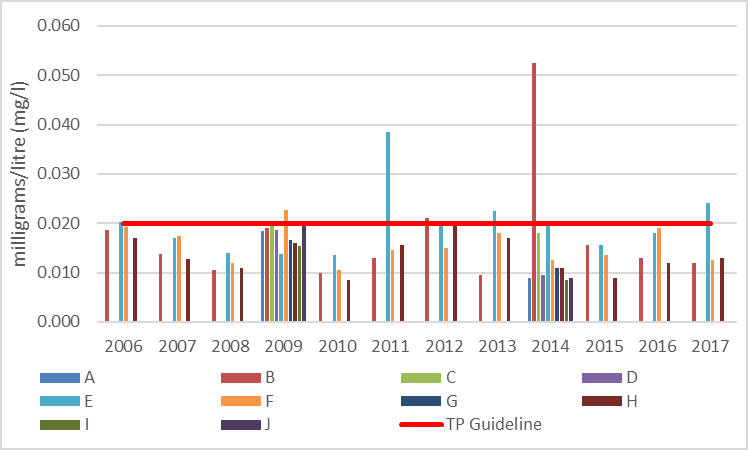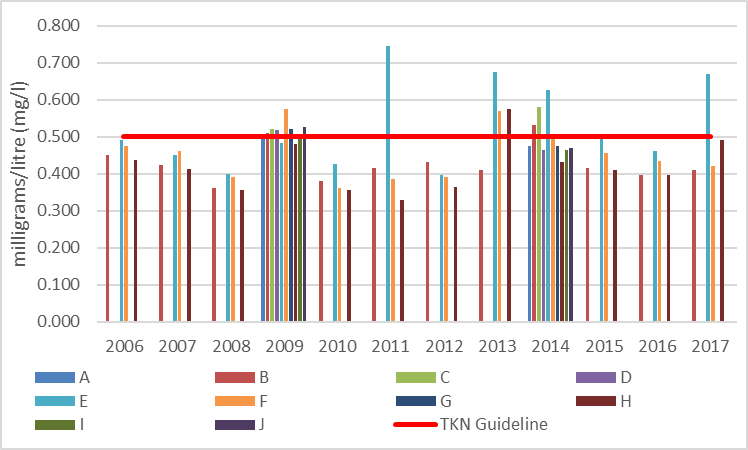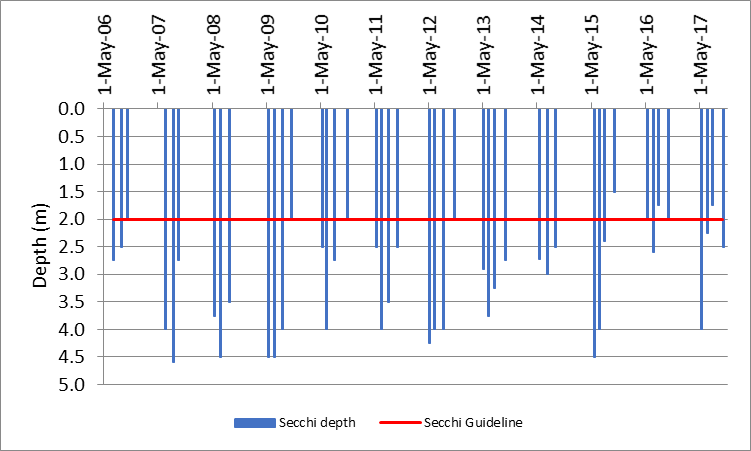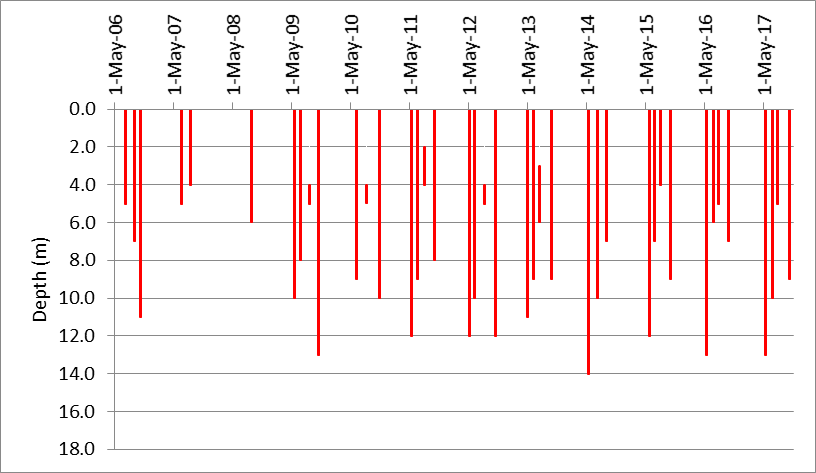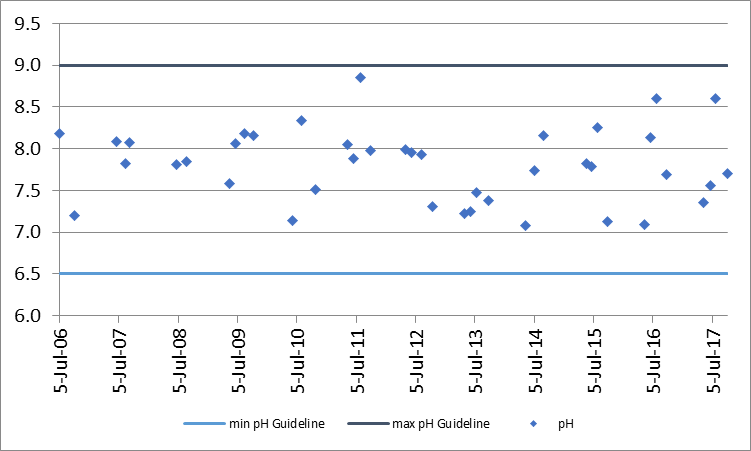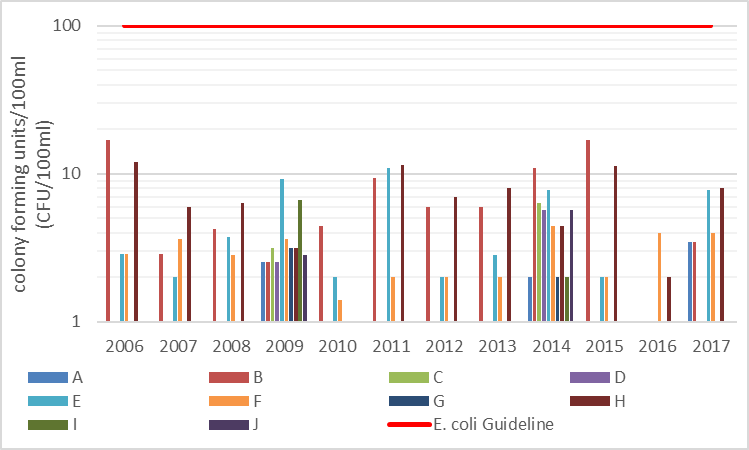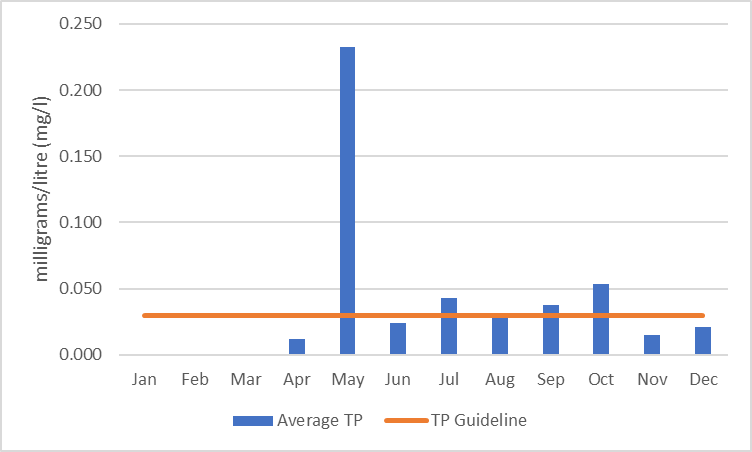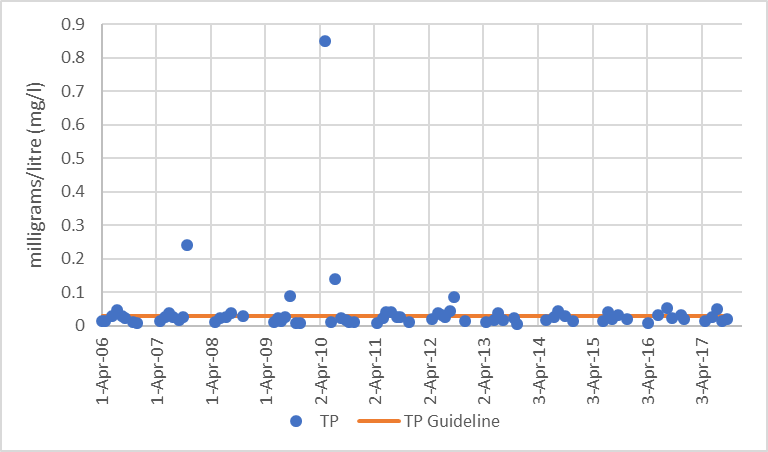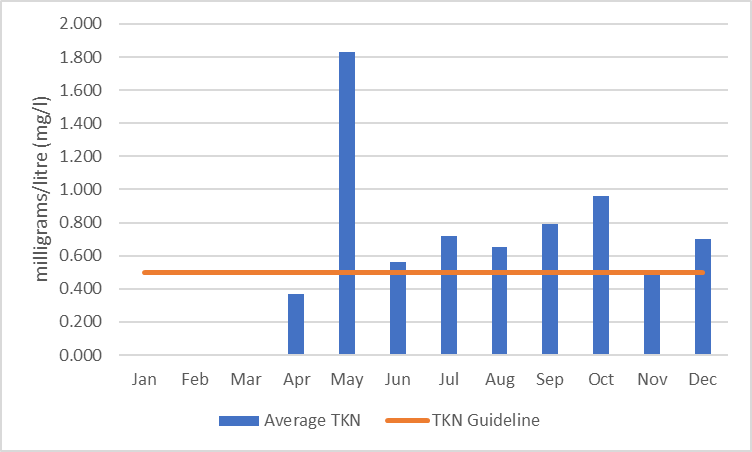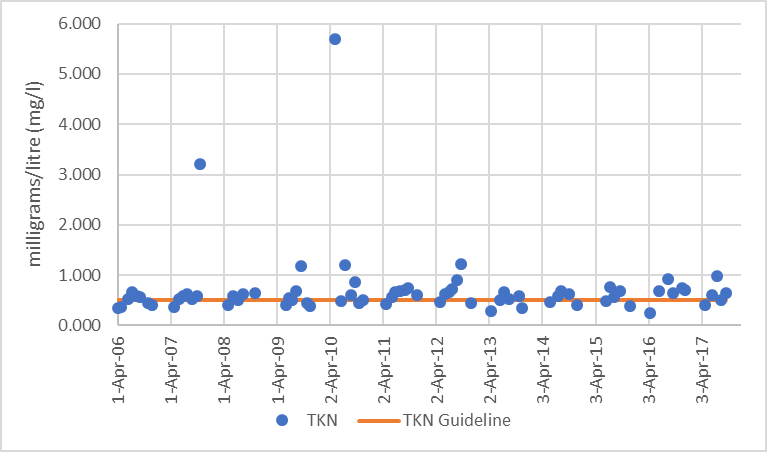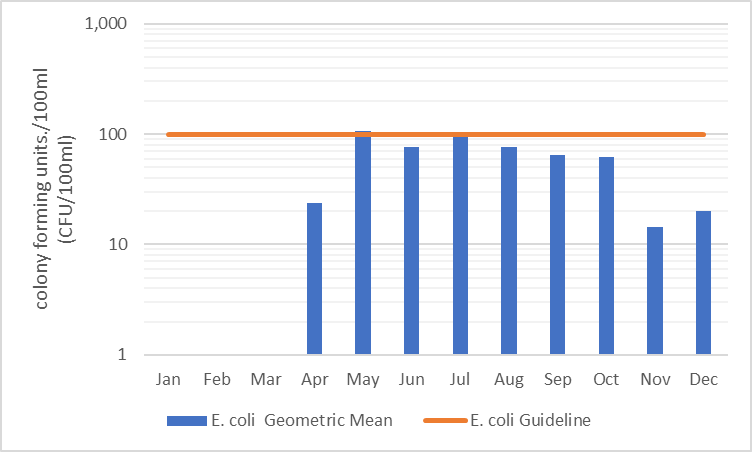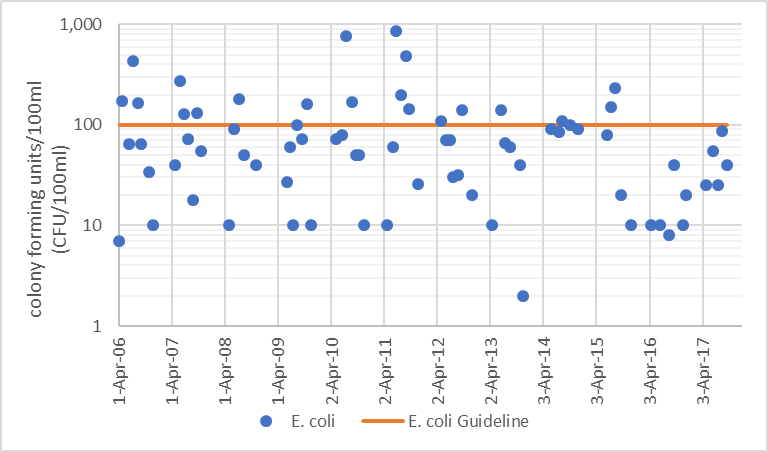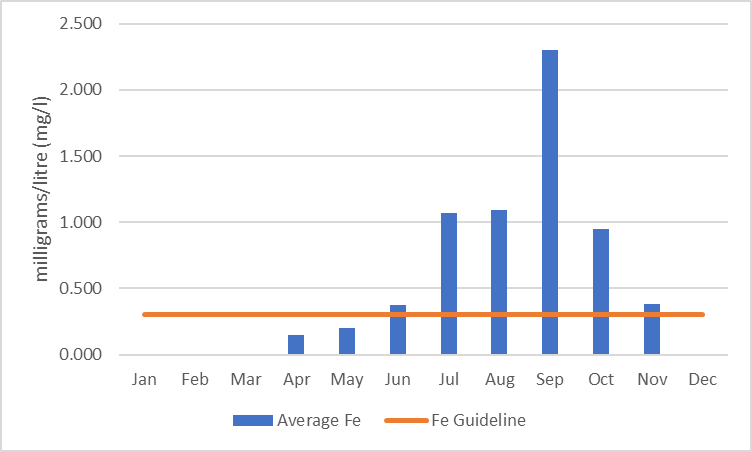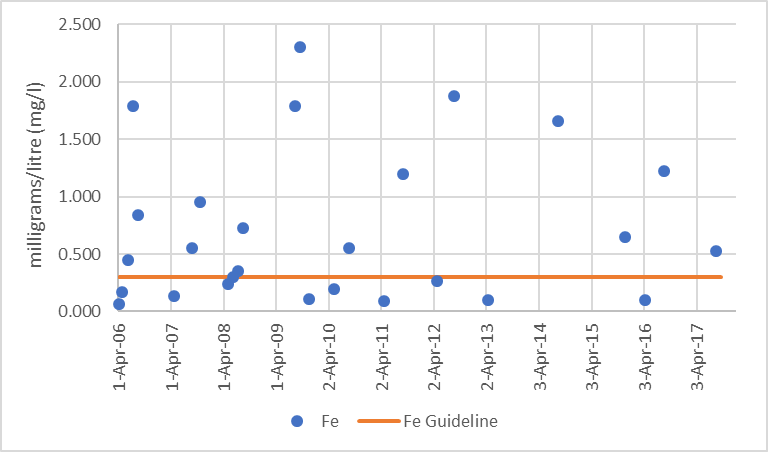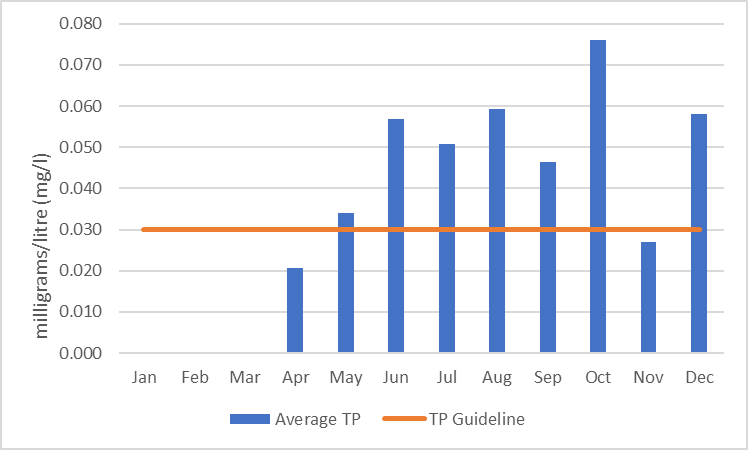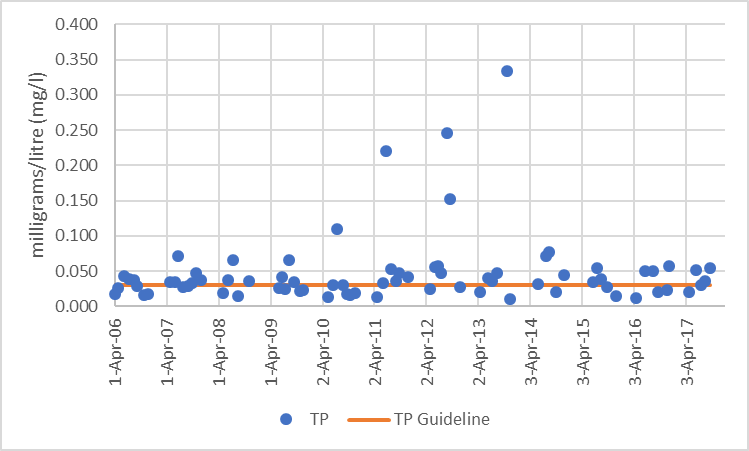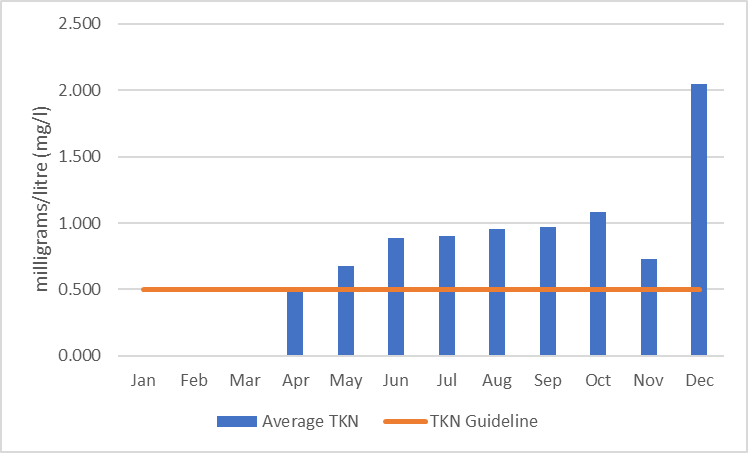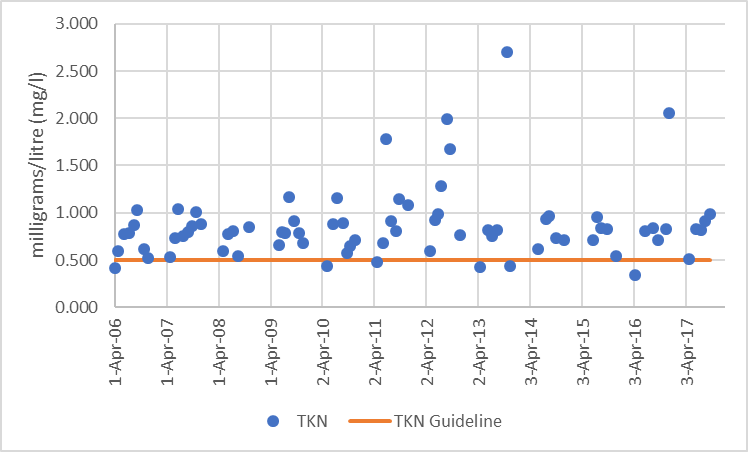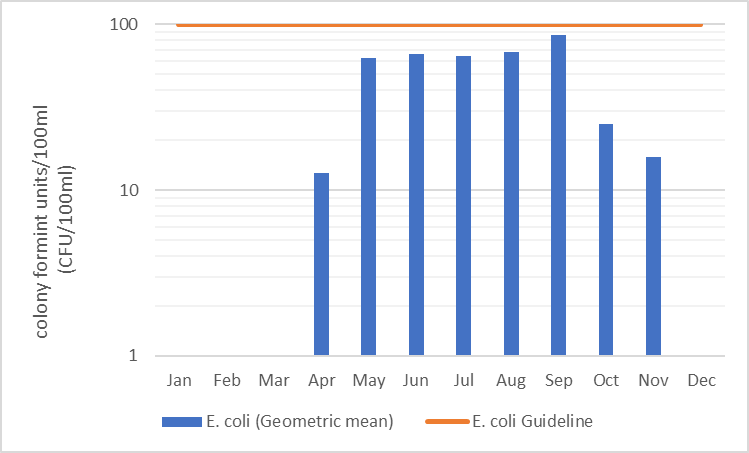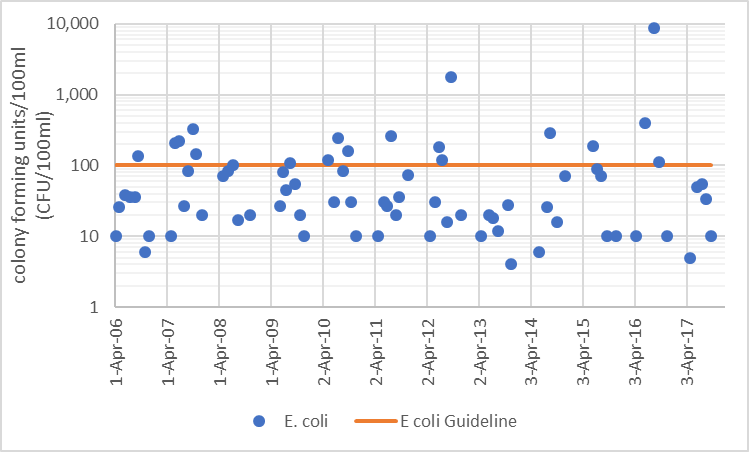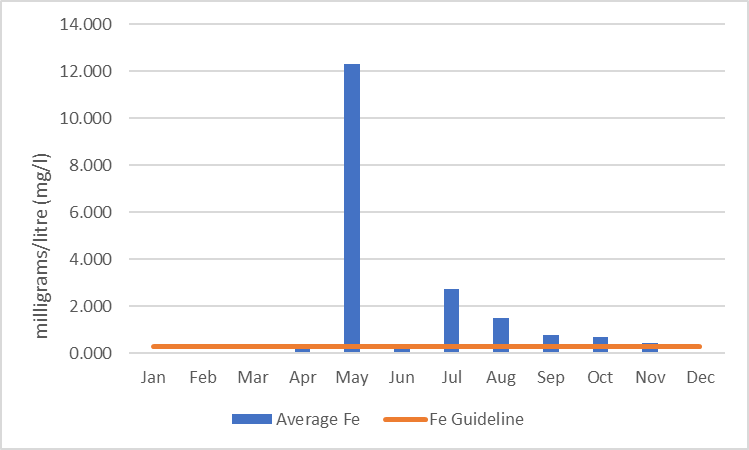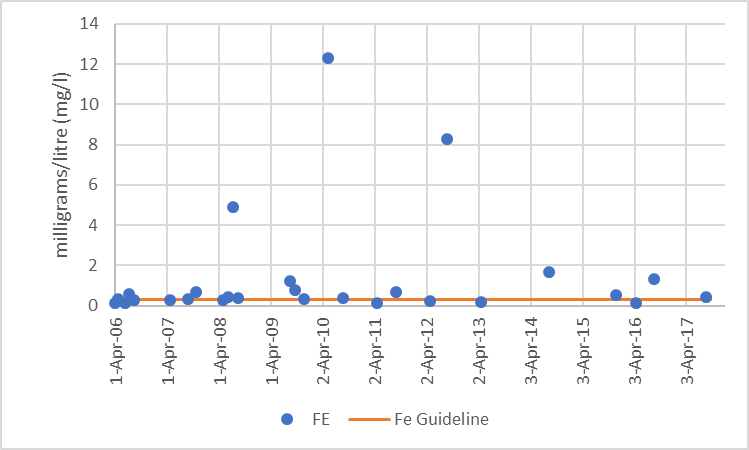2.0 Long Lake Catchment: Water Quality Conditions
Surface water quality conditions in the Long Lake catchment are monitored by the Rideau Valley Conservation Authority’s (RVCA) Watershed Watch Program and Baseline Water Quality Monitoring Program. Watershed Watch monitors watershed lakes to assess nutrient concentrations, water clarity, dissolved oxygen availability and pH. The baseline water quality program focuses on streams; data is collected for 22 parameters including nutrients (total phosphorus, total Kjeldahl nitrogen and ammonia), E. coli, metals (like aluminum and copper) and additional chemical/physical parameters (such as alkalinity, chlorides, pH and total suspended solids). Figure 2 shows the locations of monitoring sites in the catchment.
Water Quality Rating in the Long Lake Catchment
The water quality ratings scored high across this catchment and ranges from " Poor to Good" (Table 1). All ratings were determined by the Canadian Council of Ministers of the Environment (CCME) Water Quality Index. A “Poor” rating indicates that water quality is frequently threatened or impaired; conditions often depart from natural or desirable levels. A "Fair" rating indicates that water quality is usually protected but is occasionally threatened or impaired; conditions sometimes depart from natural or desirable levels. A rating of "Good" indicates that only a minor degree of threat or impairment is observed and conditions rarely depart from natural or desirable levels. Each parameter is evaluated against established guidelines to determine water quality conditions. Those parameters that frequently exceed guidelines are presented below. Data has been analyzed over the 2006-2017 period for general trends and conditions. Table 1 shows the overall rating for the monitored surface water quality sites within the catchment and Table 2 outlines the Water Quality Index (WQI) scores and their corresponding ratings.
| Site | Location | 2006-2008 | 2009-2011 | 2012-2014 | 2015-2017 |
|---|---|---|---|---|---|
| DP1 | Long Lake | Good (88) | Fair (65) | Fair (77) | Fair (76) |
| DP1 | Carnahan Lake | Fair (76) | Fair (65) | Poor (53) | Fair (77) |
| STU-01 | Stubbs Creek at Babcock Rd | Fair (74) | Fair (73) | Good (82) | Good (82) |
| UEN-01 | Uens Creek at Babcock Rd | Fair (70) | Poor (59) | Fair (69) | Fair (72) |
| Rating | Index Score |
|---|---|
| Very Good (Excellent) | 95-100 |
| Good | 80-94 |
| Fair | 65-79 |
| Poor (Marginal) | 45-64 |
| Very Poor (Poor) | 0-44 |
2.1 Carnahan Lake Water Quality
Surface water quality conditions in Carnahan Lake have been monitored by RVCA’s Watershed Watch Program since 2004. Data from the deep point site (DP1) have been used to calculate the WQI rating for Carnahan Lake, which averaged “Poor-Fair” over the 2006-2017 period (Table 1). Moderate nutrient concentrations, periods of limited oxygen availability and generally clear water all influenced this rating. The following discussion explains how each of the monitored water quality parameters contributes to the lake’s water quality.
This report also considers data from five additional shoreline sites that are monitored around the lake. These sites have not been included in the calculation of the CCME WQI rating, as they are not monitored with the same frequency as the deep point site. However, they do provide important information on water quality conditions in the near shore areas. For locations of shoreline sites (A-E) please see Figure 2.
2.1.1. Carnahan Lake Nutrients
Total phosphorus (TP) is used as a primary indicator of excessive nutrient loading and contributes to abundant aquatic vegetation growth and depleted dissolved oxygen levels. The Provincial Water Quality Objective (PWQO) is used as the TP Guideline and states that in lakes, concentrations greater than 0.020 mg/l indicate an excessive amount of TP within the water column. Concentrations below 0.010 mg/l are generally considered to be minimal and unlikely to have problems associated with nutrient loading.
Total Kjeldahl nitrogen (TKN) is used as a secondary indicator of nutrient loading. RVCA uses a guideline of 0.500 mg/l to assess TKN[1] within surface waters.
Carnahan Lake at the Deep Point
TP and TKN sampling results collected by the RVCA are presented in Figures 3 to 6. Some variability has occurred in the sampled TP concentrations at this site (Figures 3 and 4); no significant trend was observed in the 2006-2017 data set. Eighty percent of samples analyzed for TP were less than the TP guideline and the average concentration was 0.015 mg/l (Table 3). TKN concentration also showed variability, as with TP concentrations no significant change was observed (Figures 5 and 6). Sixty-eight percent of reported results were below the TKN guideline and the average TKN concentration was 0.460 mg/l (Table 3).
Overall, the data presented indicates that nutrient concentration may be considered moderate with occasional exceedances in the mid-lake, deep water site on Carnahan Lake.
| Total Phosphorous 2006-2017 | |||
|---|---|---|---|
| Site | Average (mg/l) | Below Guideline | No. Samples |
| DP1 | 0.015 | 80% | 44 |
| Total Kjeldahl Nitrogen 2006-2017 | |||
| Site | Average (mg/l) | Below Guideline | No. Samples |
| DP1 | 0.460 | 68% | 44 |
Nutrients around Carnahan Lake
The average nutrient concentrations at monitored shoreline sites around the lake vary from year to year (Figures 7 and 8). Please note that in the 2006-2017 monitoring period sites A,C and E were monitored yearly; while sites B and D were only sampled in 2009 and 2014.
Average total phosphorous concentrations are below the TP guideline at the majority of sites throughout the monitoring period, with the exception of site A (Figure 7). This site monitors a shallow bay with inflow from a small creek. This creek runs through a significant wetland area and is likely bringing in naturally released nutrients from upstream. The low concentrations of TP at other monitored sites (Figure 7) provide support that nutrient loading is not a significant problem around the lake.
A similar pattern is observed in TKN data, specifically elevated concentrations at site A (Figure 8). Elevated results were also observed at all sites in 2009, this may be due to an external factor such as weather conditions that influenced the lake at the time of sampling.
Summary of Carnahan Lake Nutrients
Carnahan Lake nutrient concentrations are generally below the guidelines. It is possible that occasional problems with nutrient enrichment (i.e. algal blooms or excessive plant growth) may be observed in some shallow, sheltered bays.
Efforts such as the diversion of runoff and enhanced shoreline buffers are important to continue to protect and enhance water quality, and reduce future nutrient increases-particularly in developed areas. Nutrient exceedances may be partially attributed to the natural aging of a lake and basin characteristics. All residents can help minimize their impact on the lake by reducing nutrient inputs through practices such as proper maintenance of septic systems, keeping shorelines natural and using phosphate free soaps and detergents. Promotion of sound stewardship and protection around lake is important to maintain and protect water quality conditions into the future.
2.1.2 Carnahan Lake Water Clarity
Water clarity is measured using a Secchi disk during each deep point sample. Table 4 summarizes the recorded depths with an average depth of 3.2 m and shows that 93 percent readings have exceeded the minimum PWQO of 2 m; indicating that algae in the water column is not at excessive levels (good water clarity). Less than 2 m will indicate overproduction in a lake or significant inputs to the water column that are limiting light availability. Figure 9 shows that measured depths range from 1.9 m to 5 m. No significant change was noted in Secchi depth over the 2006-2017 period.
| Secchi 2006-2017 | |||
|---|---|---|---|
| Site | Average (m) | Above Guideline | No. Samples |
| DP1 | 3.2 | 93% | 43 |
Summary of Carnahan Lake Water Clarity
Waters in Carnahan Lake are usually clear and sufficient sunlight is able to penetrate the water column to support aquatic life and provide sufficient visibility for safe recreational use (boating, swimming).
2.1.3 Carnahan Lake Fish Habitat
Two other factors, dissolved oxygen/temperature and pH were also assessed to provide an overall sense of the health of Carnahan Lake from a fish habitat perspective.
2.1.3.1 Carnahan Lake Dissolved Oxygen and Temperature
The red bars in Figure 10 show the depths where suitable conditions exist for warm water fish species (temperature less than 25°C and dissolved oxygen greater than 4 mg/l) at the deep point site. The vertical axis represents the total lake depth at each site where the profile is taken. Suitable conditions typically were observed over the monitoring periods to about 5 m of the water column. Periods of very limited conditions were observed in the summers of 2009-2013, due to very warm water temperatures in the upper portion of the water column and depleted oxygen conditions at the deeper depths. Overall, no significant change was noted in conditions through the 2006-2017 period.
2.1.3.2 Carnahan Lake pH
All samples (Figure 11) were within guidelines established by the Canadian Council of Minister's of the Environment which state that pH should be between 6.5 and 9 to protect aquatic life (Table 5). Biological activities such as increased photosynthesis from algal blooms and plant growth may influence pH in addition to anthropogenic activities.
| pH 2006-2017 | |||
|---|---|---|---|
| Site | Average (mg/l) | Within Guideline | No. Samples |
| DP1 | 7.7 | 100% | 39 |
Summary of Water Quality for Fish Habitat in Carnahan Lake
Overall the water chemistry data at the deep point describes suitable habitat conditions for warm water fish species. pH conditions are within the range recommended for the protection of aquatic life. Overall, the data indicates a healthy environment for aquatic species.
2.1.4 Carnahan Lake E. Coli
E. coli is sampled at monitored shoreline sites twice each sampling season. E. coli data was not used in the calculations of the WQI rating for the lake due to differences in sampling frequency and site locations. E. coli data has been summarized in Table 10.
Throughout the 2006-2017 period the majority of samples collected by RVCA were below the E. coli guideline of 100 colony forming units (CFU) per 100 ml set by the PWQO; across the lake the count at the geometric mean was 8 CFU/100ml (Table 6). This provides support that there is little indication of bacterial contamination around the lake. Figure 12 show the distribution of counts across all shoreline sites. Counts at site A are elevated compared to other sites, this can likely be attributed to wildlife presence rather than sewage pollution.
| E. coli 2006-2017 | |||
|---|---|---|---|
| Site | Geometric mean (CFU/100ml) | Below Guideline | No. Samples |
| A-E | 8 | 94% | 89 |
Summary of Bacterial Contamination
The results presented above indicate that bacterial contamination is not a significant concern in Carnahan Lake and the water should be safe for recreational use such as swimming and boating.
2.2 Long Lake Water Quality
Surface water quality conditions in Long Lake have been monitored by RVCA’s Watershed Watch Program since 2004. Data from the deep point site (DP1) have been used to calculate the WQI rating for Long Lake, which averaged “Fair-Good” over the 2006-2017 period (Table 1). Low-moderate nutrient concentrations, periods of limited oxygen availability and generally clear water all influenced this rating. The following discussion explains how each of the monitored water quality parameters contributes to the lake’s water quality.
This report also considers data from 10 additional shoreline sites that are monitored around the lake. These sites have not been included in the calculation of the CCME WQI rating, as they are not monitored with the same frequency as the deep point site. However, they do provide important information on water quality conditions in the near shore areas. For locations of shoreline sites (A-J) please see Figure 2.
2.2.1 Long Lake Nutrients
Total phosphorus (TP) is used as a primary indicator of excessive nutrient loading and contributes to abundant aquatic vegetation growth and depleted dissolved oxygen levels. The Provincial Water Quality Objective (PWQO) is used as the TP Guideline and states that in lakes, concentrations greater than 0.020 mg/l indicate an excessive amount of TP within the water column. Concentrations below 0.010 mg/l are generally considered to be minimal and unlikely to have problems associated with nutrient loading.
Total Kjeldahl nitrogen (TKN) is used as a secondary indicator of nutrient loading. RVCA uses a guideline of 0.500 mg/l to assess TKN[1] within surface waters.
Nutrients at the Long Lake Deep Point
TP and TKN sampling results collected by the RVCA are presented in Figures 13 to 16. Some variability has occurred in the sampled TP concentrations at this site (Figures 13 and 14); no significant trend[2] was observed in the 2006-2017 data set. Eighty-seven percent of samples analyzed for TP were less than the TP guideline and the average concentration was 0.014 mg/l (Table 7). TKN concentrations were fairly consistent, as with TP concentrations no significant change was observed (Figures 15 and 16). Eighty-seven percent of reported results were below the TKN guideline and the average TKN concentration was 0.416 mg/l (Table 7).
Overall, the data presented indicates that nutrient concentration may be considered moderate with occasional exceedances in the mid-lake, deep water site on Long Lake.
| Total Phosphorous 2006-2017 | |||
|---|---|---|---|
| Site | Average (mg/l) | Below Guideline | No. Samples |
| DP1 | 0.014 | 87% | 45 |
| Total Kjeldahl Nitrogen 2003-2008 | |||
| Site | Average (mg/l) | Below Guideline | No. Samples |
| DP1 | 0.416 | 87% | 45 |
Nutrients around Long Lake
The average nutrient concentrations at monitored shoreline sites around the lake vary from year to year (Figures 17 and 18). Please note that in the 2006-2017 monitoring period sites B, E, F and H were monitored yearly; while sites A, C, D, G, I and J were only sampled in 2009 and 2014.
Average total phosphorous concentrations are below the TP guideline at the majority of sites throughout the monitoring period (Figure 17), periods of elevated results were observed at site E in 2011, 2013 and 2017, site F in 2009 and site B in 2014. These three sites (E, F an B) are not persistently elevated therefore these few elevated samples are not likely to be of great concern. The low concentrations of TP at other monitored sites (Figure 17) provide support that nutrient loading is not a significant problem around the lake.
A similar pattern is observed in TKN data, specifically elevated concentrations at site E in 2011, 2013, 2014 and 2017 (Figure 18). Since site E is at the outflow of the lake, elevated counts may indicate higher loads associated with wet weather years.
Summary of Long Lake Nutrients
Long Lake nutrient concentrations are generally below the guidelines. It is possible that occasional problems with nutrient enrichment (i.e. algal blooms or excessive plant growth) may be observed in some shallow, sheltered bays.
Efforts such as the diversion of runoff and enhanced shoreline buffers are important to continue to protect and enhance water quality, and reduce future nutrient increases-particularly in developed areas. Nutrient exceedances may be partially attributed to the natural aging of a lake and basin characteristics. All residents can help minimize their impact on the lake by reducing nutrient inputs through practices such as proper maintenance of septic systems, keeping shorelines natural and using phosphate free soaps and detergents. Promotion of sound stewardship and protection around lake is important to maintain and protect water quality conditions into the future.
2.2.2 Long Lake Water Clarity
Water clarity is measured using a Secchi disk during each deep point sample. Table 8 summarizes the recorded depths with an average depth of 3.1 m and shows that 80 percent of readings have exceeded the minimum PWQO of 2 m; indicating that algae in the water column is not at excessive levels (good water clarity). Less than 2 m will indicate overproduction in a lake or significant inputs to the water column that are limiting light availability. Figure 19 shows that measured depths range from 1.5 m to 4.6 m. A decline was observed in Secchi depths over the 2006-2017 data set, meaning that clarity in the water column has been reduced in this period.
| Secchi 2006-2017 | |||
|---|---|---|---|
| Site | Average (m) | Above Guideline | No. Samples |
| DP1 | 3.1 | 80% | 44 |
Summary of Long Lake Water Clarity
Waters in Long Lake are usually clear and sufficient sunlight is able to penetrate the water column to support aquatic life and provide sufficient visibility for safe recreational use (boating, swimming).
2.2.3 Long Lake Fish Habitat
Two other factors, dissolved oxygen/temperature and pH were also assessed to provide an overall sense of the health of Long Lake from a fish habitat perspective.
2.2.3.1 Long Lake Dissolved Oxygen and Temperature
The red bars in Figure 20 show the depths where suitable conditions exist for warm water fish species (temperature less than 25°C and dissolved oxygen greater than 4 mg/l) at the deep point site. The vertical axis represents the total lake depth at each site where the profile is taken. Suitable conditions typically were observed over the monitoring periods to about 8 m of the water column. Periods of very limited conditions were observed in the summers of 2009-2013, due to very warm water temperatures in the upper portion of the water column and depleted oxygen conditions at the deeper depths. Overall, no significant change was noted in conditions through the 2006-2017 period.
2.2.3.2 Long Lake pH
All samples (Figure 21) were within guidelines established by the Canadian Council of Minister's of the Environment which state that pH should be between 6.5 and 9 to protect aquatic life (Table 9). Biological activities such as increased photosynthesis from algal blooms and plant growth may influence pH in addition to anthropogenic activities.
| pH 2006-2017 | |||
|---|---|---|---|
| Site | Average (mg/l) | Within Guideline | No. Samples |
| DP1 | 7.8 | 100% | 41 |
Summary of Water Quality for Fish Habitat in Long Lake
Overall the water chemistry data at the deep point describes suitable habitat conditions for warm water fish species. pH conditions are within the range recommended for the protection of aquatic life. Overall, the data indicates a healthy environment for aquatic species.
2.2.4 Long Lake E. Coli
E. coli is sampled at monitored shoreline sites twice each sampling season. E. coli data was not used in the calculations of the WQI rating for the lake due to differences in sampling frequency and site locations. E. coli data has been summarized in Table 10.
Throughout the 2006-2017 period all samples collected by RVCA were below the E. coli guideline of 100 colony forming units (CFU) per 100 ml set by the PWQO; across the lake the count at the geometric mean was 4 CFU/100ml (Table 6). This provides support that there is little indication of bacterial contamination around the lake. Figure 22 show the distribution of counts across all shoreline sites.
| E. coli 2006-2017 | |||
|---|---|---|---|
| Site | Geometric mean (CFU/100ml) | Below Guideline | No. Samples |
| A-J | 4 | 100% | 137 |
Summary of Long Lake Bacterial Contamination
The results presented above indicate that bacterial contamination is not a significant concern in Long Lake and the water should be safe for recreational use such as swimming and boating.
2.3 Stubb Creek Water Quality
There is one water quality monitoring site on Stubb Creek (STU-01) (Figure 2). Water quality was determined to be “Good” (Table 1). The score at this site was largely influenced by occasionally elevated nutrient concentrations, iron and bacterial counts. For more information on the CCME WQI, please see the Tay River Subwatershed Report 2017.
2.3.1 Stubb Creek Nutrients
Total phosphorus (TP) is used as a primary indicator of excessive nutrient loading and may contribute to abundant aquatic vegetation growth and depleted dissolved oxygen levels. The Provincial Water Quality Objective (PWQO) is used as the TP Guideline and states that in streams concentrations greater than 0.030 mg/l indicate an excessive amount of TP.
Total Kjeldahl nitrogen (TKN) is used as a secondary indicator of nutrient loading. RVCA uses a guideline of 0.500 mg/l to assess TKN[1].
Tables 11 and 12 summarize average nutrient concentrations at the monitored sites within the Stubb Creek catchment and show the proportion of results that met the guidelines.
| Total Phosphorus 2006-2017 | |||
|---|---|---|---|
| Site | Average (mg/l) | Below Guideline | No. Samples |
| STU-01 | 0.040 | 72% | 75 |
| Total Kjeldahl nitrogen 2006-2017 | |||
|---|---|---|---|
| Site | Average (mg/l) | Below Guideline | No. Samples |
| STU-01 | 0.695 | 29% | 75 |
Monitoring Site STU-01
Elevated TP results occurred occasionally at site STU-01 throughout the monitoring period; 72% of samples were below the guideline (Figure 24) and average concentrations are variable across the sampled months (Figure 23). Please note a significantly high sample in May of 2010 (Figure 24) has had a strong influence of the average May results (Figure 23) through the monitoring period. The average TP concentration was above the guideline of 0.030 mg/l at 0.040mg/l (Table 11).
The majority of TKN results have exceeded the guideline (Figure 26); 29 percent of samples were below the guideline. The average concentration was 0.695 mg/l and exceeded the guideline of 0.500 mg/l (Table 12). As with the TP data set, an elevated sample in May 2010 (Figure 26) has a strong influence on the monthly average for May (Figure 25). Average monthly samples generally exceeded the guideline with the exception of April and November.
There was no significant change in the sampled concentrations of TP or TKN at this site over the 2006-2017 period (Figure 24 and 26).
Summary of Stubb Creek Nutrients
The data shows that periods of elevated nutrients occur occasionally in Stubb Creek. Elevated nitrogen is likely due to the influence of surrounding wetland areas. Wetlands are naturally rich in nitrogen and appear to be contributing to the concentrations in this creek. Though this is likely to be a natural condition it is important to reduce human impacts wherever possible. Strategies to reduce nutrient inputs may include diversion of runoff to the creek from surrounding developed areas (i.e. roadways) and enhanced shoreline buffers.
2.3.2 Stubb Creek E. coli
Escherichia coli (E. coli) is used as an indicator of bacterial pollution from human or animal waste; in elevated concentrations it can pose a risk to human health. The PWQO of 100 colony forming units/100 millilitres (CFU/100 ml) is used as a guideline. E. coli counts greater than this guideline indicate that bacterial contamination may be a problem within a waterbody.
Table 13 summarizes the geometric mean[2] for the monitored site on Stubb Creek and shows the proportion of samples that meet the E. coli guideline of 100 CFU/100 ml. The results of the geometric mean with respect to the guideline for the 2006-2017 period are shown in Figures 27 and 28.
| E. coli 2006-2017 | |||
|---|---|---|---|
| Site | Geometric Mean (CFU/100ml) | Below Guideline | No. Samples |
| STU-01 | 52 | 71% | 75 |
Monitoring Site STU-01
E. coli counts at site STU-01 show that there has been no significant trend in bacterial counts (Figure 28). The count at the geometric mean was 52 (Table 13), and majority of results (71 percent) were below the E. coli guideline. Figure 27 shows that counts are generally highest from May to October; this can likely be attributed to warm weather and reduced flow conditions, the geometric mean did not exceed the guideline in any of the sampled months.
Summary of Stubb Creek Bacterial Contamination
Bacterial contamination does not appear to be a significant concern in Stubb Creeks. As indicated by Figure 28 occasional exceedances above the guideline of 100 CFU/100ml have been observed. Best management practices such as enhancing shoreline buffers, limiting livestock access and minimizing runoff in both rural and developed areas can help to protect Stubb Creek into the future.
2.3.3 Stubb Creek Metals
Of the metals routinely monitored in Stubb Creek iron (Fe) occasionally reported concentrations above its respective Provincial Water Quality Objective of 0.300 mg/l. In elevated concentrations, this metal can have toxic effects on sensitive aquatic species.
Table 14 summarizes Fe concentrations within the creek as well as show the proportion of samples that meet guidelines. Figures 29 and 30 show Fe concentrations with respect to the guidelines for the monitoring period, 2006-2017.
| Iron 2006-2017 | |||
|---|---|---|---|
| Site | Average (mg/l) | Below Guideline | No. Samples |
| STU-01 | 0.711 | 37% | 27 |
Monitoring Site STU-01
The average Fe concentrations in site STU-01 was 0.711 mg/l and exceeded the guideline (PWQO). Thirty-seven percent of samples were below the guideline and there was no significant change in Fe concentrations across the monitoring period (Table 14, Figure 30). Monthly concentrations were elevated through the summer months, with the highest concentrations observed in September (Figure 30).
Summary of Stubb Creek Metals
In Stubb Creek there is evidence of increased metal concentration above respective guidelines, it is quite likely that they are naturally occurring from groundwater inputs. Even so, continued efforts should be made to protect against possible pollution sources and implement best management practices to reduce any inputs such as storm water runoff from hardened surfaces to improve overall stream health and lessen downstream impacts.
2.4 Uens Creek Water Quality
There is one water quality monitoring site on Uens Creek (UEN-01) (Figure 1). Water quality was determined to be “Fair” (Table 1). The score at this site was largely influenced by frequently elevated nutrient concentrations, as well as elevated iron and bacterial counts. For more information on the CCME WQI, please see the Tay River Subwatershed Report 2017.
2.4.1 Uens Creek Nutrients
Total phosphorus (TP) is used as a primary indicator of excessive nutrient loading and may contribute to abundant aquatic vegetation growth and depleted dissolved oxygen levels. The Provincial Water Quality Objective (PWQO) is used as the TP Guideline and states that in streams concentrations greater than 0.030 mg/l indicate an excessive amount of TP.
Total Kjeldahl nitrogen (TKN) is used as a secondary indicator of nutrient loading. RVCA uses a guideline of 0.500 mg/l to assess TKN[1].
Tables 15 and 16 summarize average nutrient concentrations at the monitored site on Uen's Creek and show the proportion of results that met the guidelines.
| Total Phosphorus 2006-2017 | |||
|---|---|---|---|
| Site | Average (mg/l) | Below Guideline | No. Samples |
| UEN-01 | 0.047 | 38% | 77 |
| Total Kjeldahl nitrogen 2006-2017 | |||
|---|---|---|---|
| Site | Average (mg/l) | Below Guideline | No. Samples |
| UEN-01 | 0.860 | 8% | 75 |
Monitoring Site UEN-01
Elevated TP results occurred regularly at site UEN-01 throughout the 2006-2017 period; only 38% of samples were below the guideline (Figure 32). Average concentrations increased throughout the summer months and into the early fall (Figure 31). Please note a significantly high sample in October 2013 (Figure 32) has had a strong influence of the average October results (Figure 31) through the monitoring period. The average TP concentration was above the guideline of 0.030 mg/l at 0.047 mg/l (Table 15).
The majority of TKN results have exceeded the guideline (Figure 34). Very few samples (8 percent) were below the guideline. The average concentration was 0.860 mg/l and exceeded the guideline of 0.500 mg/l (Table 16). Concentrations appear to be the lowest in the early spring and increase through the summer months (Figure 33).
There was no significant change in the sampled concentrations of TP or TKN at this site over the 2006-2017 period (Figure 32 and 34).
Summary of Uens Creek Nutrients
Results of the monitored site on Uen Creek shows that periods of nutrient enrichment are a feature of this creek, particularly with respect to nitrogen. Elevated nutrients may result in nutrient loading downstream. High nutrient concentrations can help stimulate the growth of algae blooms and other aquatic vegetation in a waterbody and deplete oxygen levels as the vegetation dies off. Development in this area is also minimal but best management practices such as minimizing storm water runoff, enhanced shoreline buffers, minimizing/discontinuing the use of fertilizers and restricting livestock access in both surrounding agricultural and developed areas can help to reduce additional nutrient enrichment both within this creek.
2.4.2 Uens Creek Escherichia coli
Escherichia coli (E. coli) is used as an indicator of bacterial pollution from human or animal waste; in elevated concentrations it can pose a risk to human health. The PWQO of 100 colony forming units/100 millilitres (CFU/100 ml) is used as a guideline. E. coli counts greater than this guideline indicate that bacterial contamination may be a problem within a waterbody.
Table 17 summarizes the geometric mean[2] for the monitored site on Uen Creek and shows the proportion of samples that meet the E. coli guideline of 100 CFU/100 ml. The results of the geometric mean with respect to the guideline for the 2006-2017 period are shown in Figures 35 and 36.
| E. coli 2012-2017 | |||
|---|---|---|---|
| Site | Geometric Mean (CFU/100ml) | Below Guideline | No. Samples |
| UEN-01 | 41 | 74% | 76 |
Monitoring Site UEN-01
E. coli counts at site UEN-01 show that there has been no significant trend in bacterial counts (Figure 36). The count at the geometric mean was 41 (Table 17), and majority of results (74 percent) were below the E. coli guideline. Figure 35 shows that counts are generally highest during the summer months; this can likely be attributed to warm weather and reduced flow conditions, the geometric mean did not exceed the guideline in any of the sampled months.
Summary of Uens Creek Bacterial Contamination
Bacterial contamination does not appear to be a significant concern in Uen Creeks. As indicated by Figure 36 occasional exceedances above the guideline of 100 CFU/100ml have been observed. Best management practices such as enhancing shoreline buffers, limiting livestock access and minimizing runoff in both rural and developed areas can help to protect Uen Creek into the future.
2.4.3 Uens Creek Metals
Of the metals routinely monitored in Uen Creek iron (Fe) occasionally reported concentrations above its respective Provincial Water Quality Objective of 0.300 mg/l. In elevated concentrations, this metal can have toxic effects on sensitive aquatic species.
Table 18 summarizes Fe concentrations within the creek as well as show the proportion of samples that meet guidelines. Figures 37 and 38 show Fe concentrations with respect to the guidelines for the monitoring period, 2006-2017.
| Iron 2006-2017 | |||
|---|---|---|---|
| Site | Average (mg/l) | Below Guideline | No. Samples |
| UEN-01 | 1.39 | 25% | 28 |
Monitoring Site UEN-01
The average Fe concentration in site UEN-01 was 1.390 mg/l and exceeded the guideline (PWQO). Only 25 percent of samples were below the guideline and there was no significant change in Fe concentrations across the monitoring period (Table 18, Figure 38). Monthly concentrations are highly influenced by samples in May 2010 and August 2012 (Figures 37 and 38). The majority of samples analyzed for metals have been collected in April and August to capture metal concentrations in high and low flow conditions.
Summary of Uens Creek metals
In Uen creek there is evidence of increased metal concentration above respective guidelines, it is quite likely that the largest source of Fe is naturally occurring from groundwater inputs. Even so, continued efforts should be made to protect against possible pollution sources and implement best management practices to reduce any inputs such as storm water runoff from hardened surfaces to improve overall stream health and lessen downstream impacts.
[1] No Ontario guideline for TKN is presently available; however, waters not influenced by excessive organic inputs typically range from 0.100 to 0.500 mg/l, Environment Canada (1979) Water Quality Sourcebook, A Guide to Water Quality Parameters, Inland Waters Directorate, Water Quality Branch, Ottawa, Canada
[2] A type of mean or average, which indicates the central tendency or typical value of a set of numbers by using the product of their values (as opposed to the arithmetic mean which uses their sum). It is often used to summarize a variable that varies over several orders of magnitude, such as E. coli counts.
